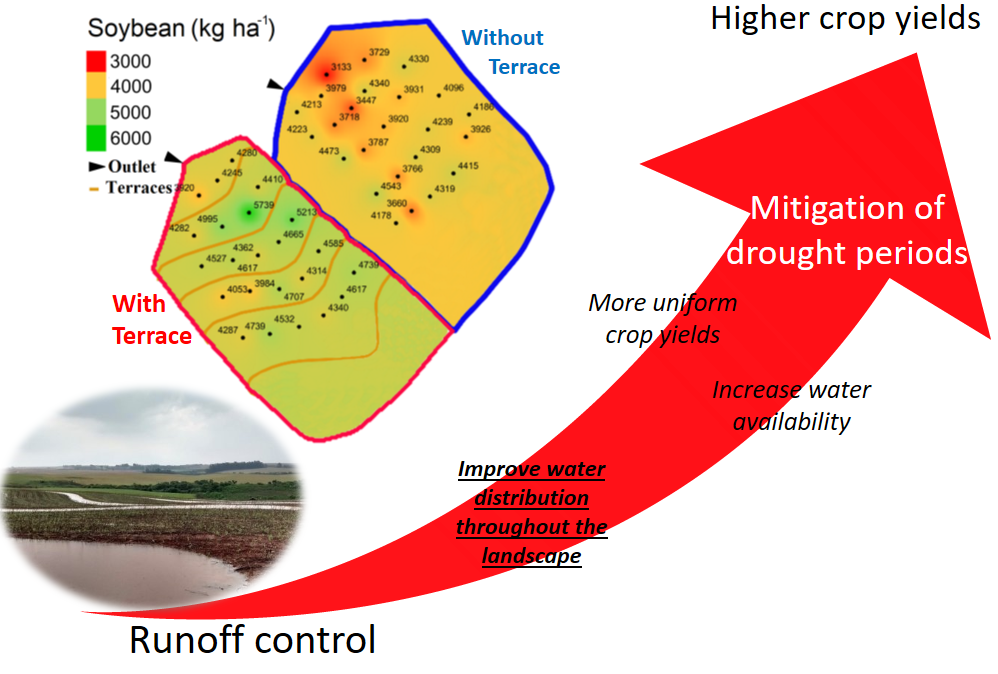Managing runoff in rainfed agriculture under no-till system: potential for improving crop production
11/Nov/2021
ABSTRACT Strategies to mitigate degradation and ensure food and water security are among the main challenges in agricultural development. Unconsolidated information about the positive impact of conservationist practices on productivity increase is fundamental for their adoption by farmers. This study evaluated if the saved rainfall excess in catchment with terrace generates higher soybean and corn yield due to greater water availability in the crop rooting zone. Experiments were conducted in southern Brazil during the agricultural years of 2016/17 (soybean) and […]
Spatial and Temporal Potential Groundwater Recharge: the Case of the Doce River Basin, Brazil
07/Jan/2019
ABSTRACT: Little is known about the groundwater recharge potential of weathered tropical catchments, where increasing water uptake is widespread to meet various water demands. This study aimed to estimate the volume of groundwater recharge of the Doce River Basin, Minas Gerais, Brazil. The BALSEQ model was applied to calculate the water balance over a period of two years (2007-2009). Evapotranspiration, runoff, and potential groundwater recharge (PGR) were calculated, using daily data on rainfall, potential evapotranspiration, and plant-available water. A soil […]
Stabilization of soil hydraulic properties under a long term no-till system
01/Aug/2014
The area under the no-tillage system (NT) has been increasing over the last few years. Some authors indicate that stabilization of soil physical properties is reached after some years under NT while other authors debate this. The objective of this study was to determine the effect of the last crop in the rotation sequence (1st year: maize, 2nd year: soybean, 3rd year: wheat/soybean) on soil pore configuration and hydraulic properties in two different soils (site 1: loam, site 2: sandy […]
Spatial continuity of the saturated hydraulic conductivity in soil of the Alto Rio Grande basin, MG
01/Oct/2011
Spatial distribution of the saturated hydraulic conductivity (k0) is essential in the study of soil erosion and surface runoff. The purpose of this study was to investigate the spatial continuity of the soil hydrologic characteristic k0 in the watershed Alto Rio Grande, state of Minas Gerais, and to map k0 based on geostatistical procedures, using data without and with logarithmic transformation. Exponential and spherical semi-variogram models were fitted to the experimental semi-variograms in two approaches: ordinary minimum square (MQO) and […]
Comparison of determination methods of hydraulic conductivity in a typic hapludox
01/Aug/2011
The hydraulic conductivity, determined as a function of the volumetric soil water content K(θ), is essential to solve, e.g., drainage problems. However, the results of different methods vary according to the different assumptions. The objective of this study was to compare direct field methods (Instantaneous Profile, Flux and Humidity) and indirect laboratory methods for estimating the hydraulic conductivity as a function of soil water content, K(θ). The experiment was carried out in Piracicaba, State of São Paulo (Brazil), with a […]
Numerical analysis of the impact of charcoal production on soil hydrological behavior, runoff response and erosion susceptibility
01/Feb/2009
The impact of charcoal production on soil hydraulic properties, runoff response and erosion susceptibility were studied in both field and simulation experiments. Core and composite samples, from 12 randomly selected sites within the catchment of Kotokosu were taken from the 0-10 cm layer of a charcoal site soil (CSS) and adjacent field soils (AFS). These samples were used to determine saturated hydraulic conductivity (Ksat), bulk density, total porosity, soil texture and color. Infiltration, surface albedo and soil surface temperature were also […]
Spatial variability of hydrodynamic parameters in two agricultural plots in Paraíba state – Brazil
01/Oct/2008
Knowledge on soil hydraulic properties such as water retention and hydraulic conductivity curves is indispensable for water and pollutant transport modeling of agricultural systems. This soil hydraulic properties are affected by numerous sources of variability, mostly associated with spatial, temporal, and management-related factors. The objective of this study was to analyze the spatial variability of parameters of water retention (van Genuchten) and hydraulic conductivity (Brooks & Corey) curves obtained with the “Beerkan” method based on simple infiltration experiments and soil […]
Soil compaction and eucalyptus growth in response to forwarder traffic intensity and load
01/Jun/2008
During timber exploitation in forest stands harvesting machines pass repeatedly along the same track and can cause soil compaction, which leads to soil erosion and restricted tree root growth. The level of soil compaction depends on the number of passes and weight of the wood load. This paper aimed to evaluate soil compaction and eucalyptus growth as affected by the number of passes and wood load of a forwarder. The study was carried out in Santa Maria de Itabira county, […]
Soil physical attributes in integrated cattle raising-crop production system under no-tillage
01/Oct/2007
Soil compaction is one of the most important reasons for decrease in crop yield. The impact of animal trampling on integrated beef cattle raising-crop production systems were studied to evaluate the changes in soil physical properties (bulk density, porosity, soil resistance to penetration and soil water infiltration). The field experiment was carried out in Jari, in the mid- plateau region of Rio Grande do Sul State, Brazil. Three management systems of winter pastures (black oat; Avena strigosa Schreber + ryegrass; […]
Movement of a solute applied in two concentrations to an unsaturated soil via a disk permeameter
01/Jun/2002
Groundwater pollution is one of the main factors justifying the study of soil solute movement and the processes of soil solute interaction. A deeper penetration than the expected of the chemicals applied to the soil surface, together with laboratory observations of the decrease of the amount of solutes in the solution passing through the soil, led researchers to consider the soil water (or solution) as having two phases: a mobile phase, θm, and an immobile phase, θim. In this paper, […]

